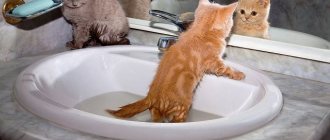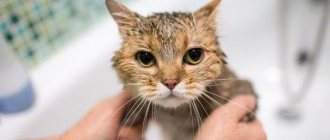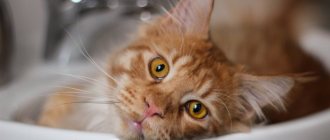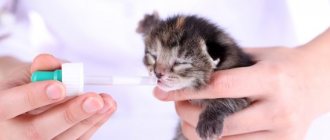To bathe a kitten or not to bathe, and if to bathe, then how? These questions become relevant when the baby is taken away from the cat and brought to a new family. Until this moment, all water procedures for the baby are performed by his mother, diligently licking her own child from the top of the head to the tip of the tail. And now it’s the turn of his new “parents”.
By this time, the kitten will be two months old; it will take some time to get used to the new home, because two stresses “for one spoon” (parting with mom and a bath day) will be too much for the baby to handle. So add about two more weeks to a couple of months - and you can take the mustachioed tabby to the bathroom.
Reasons to bathe a kitten
Does it need to be washed at all? As a rule, yes. After all, anything can happen to a mischievous person. How is the song sung? “And yesterday I climbed into the chimney…” Here is a reason for you to give him a bath for the first time.
The second important reason is that you need to teach the kitten not to be afraid of water. Even if you do not have to bathe your pet often in the future, it is useful if he learns about bathing in infancy: it is much more difficult to accustom an adult cat to water procedures. And if you prefer purebred kittens to ordinary kittens and plan to participate in exhibitions, you will have to wash the cat quite often.
A special situation is when you bring a kitten into the house from the street. Whether abandoned by someone or born in the yard, it (even if it is not two months old) needs to be washed with special products against fleas, fungus, and any parasites.
How often should kittens be washed?
Many owners are wondering at what time in the house it is possible to use this procedure. The kitten can be washed for the first time no earlier than 3 weeks after it arrives in the house. By this time, he will adapt to his new place of residence and get used to his owner. If a street kitten is taken into the house, then it must be washed without waiting for three weeks of adaptation. It is better to start bathing kittens no earlier than the first 3 months of life.
Kittens get dirty quite often, they do not go to the litter box as neatly as an adult pet, they are attracted to the flower pot, and this is normal, babies are less neat than cats. Sometimes they have to be washed several times a month.
When the pet is adapted to the house and does not get dirty too often, then washing should not exceed 2 times a month, since too frequent water procedures can dry out the skin and upset the fat balance. Sometimes this makes you vulnerable to various types of infections.
Bathing scheme suggested by veterinarians
Many veterinarians recommend to caring owners the following diagram to help them figure out how long to bathe their baby:
- A one-month-old cat needs to be bathed once a month.
- Four-month old – 2 times.
They also recommend washing associated with different seasons:
- In winter, it is recommended to wash your pet once, for example, in January.
- In spring - 2 times, for example, in March and mid-May.
- In summer - 2 times, for example, at the end of June and in August.
- In autumn - 1 time, for example, in October.
Of course, you can choose the time of washing at your own discretion, but this scheme is most adapted to the needs of the cat.
First swim
The first time is the most important. If you manage to do everything correctly, do not scare the baby, and he feels pleasure from water procedures, you will save yourself from big problems in the future.
The most common mistake is giving a kitten a bath for the first time. Large, with a lot of water, it will certainly frighten the kitten. In addition, it will be very inconvenient for you to wash it at an angle, leaning over the side and putting your hands down. Be sure that as soon as you hesitate for a second, the kitten will “fly up” onto your neck or head, climbing up your arms like up a tree trunk.
The most convenient way to wash your baby is in a basin or sink. You need to put a rubber mat or a small terry towel on the bottom. The water temperature should not be higher than 38 - 40 degrees, the “depth” should not be more than three centimeters.
It will be right if you prepare everything you need in advance: a large fluffy towel, shampoo, a bowl of water. If you have to wash the kitten alone (although it would be more convenient for two), unscrew the cap on the shampoo in advance. Prepare a couple of cotton balls soaked in sunflower oil to plug your baby's ears with, otherwise water may get into them. By the way, protect your eyes by smearing their corners with Vaseline oil.
Are you prepared? Now the most important thing is how to bathe a kitten. Take him by the withers with your hand (as the mother cat took him with her teeth) and place him in a basin of water. It doesn’t matter whether he sits or stands on all four legs, the main thing is that his posture is sufficiently stable.
Wash your baby carefully, protecting the head (especially the eyes and ears) from getting water. Do not turn on the shower - strong water pressure can frighten the kitten. Always talk to him in a normal, calm voice.
The bathing procedure should not be too long: shampoo “eats” the grease from the hair, and without it, your pet’s “fur coat” will not be shiny and smooth. There is also a risk of drying out the skin, which will become easy prey for harmful microorganisms and various infections.
After the washing is over, wrap your pet in a towel so that it is comfortable for him to breathe and look around, but under no circumstances wrap him up “with his head.” Hold the baby in your arms for a few minutes to dry him, and then put him down on the sofa - he will clean himself up. You will make sure that there are no drafts and your pet will not catch a cold.
And the last point: praise the baby for being brave and obedient (you can even play a little trick) and reward him with something tasty that he really likes. For pedagogical purposes.
Basic rules for washing kittens
It is better to keep the doors to the bathroom closed, because if the cat runs away from you, you will not need to look for it throughout the apartment.
It is necessary to wash the cat with confident movements, which include:
- The most important point is to place the animal in the bath; it is better to grab it by the scruff of the neck, so that it does not have the opportunity to scratch, break free and run away. Before you start washing the kitten, you need to wet its fur and keep its nose and ears dry. To avoid irritation, you should put eye drops in your pet's eyes and plug his ears with a tampon. Water should not get into the cat’s nose and ears, otherwise inflammatory processes may occur.
- It is most convenient to wash a kitten in the shower; this procedure will result in less splashing, and the animal will more easily endure such an ordeal. You can hold the cat with your left hand, and the shower with your right.
- The shower must first be put aside, and the shampoo must be applied to the back, paws and tummy of the pet, do not forget about the tail.
- Last but not least, you can wash the baby’s head, because this is the most unpleasant part of this procedure.
- A soft sponge should be used for washing.
- The easiest way to wash off the foam is with a shower from top to bottom, but you need to make sure that water does not get into the cat’s ears.
- After the pet has taken a bath, all the foam has been washed off, it must be placed in a warm towel. It is best to use two towels, and one of them must be thick, because it is unknown how the cat will behave after washing.
- You should not bathe your pet after he has eaten. The bath should be used no earlier than 4 hours after eating.
If the kitten has survived vaccination, then it will be possible to wash it no earlier than after 2 weeks.
Bathing products used
You cannot bathe a kitten with regular human shampoo. The fact is that shampoo for people, including children and even allergy sufferers, may contain substances that are dangerous for a young cat’s body. The baby may be sensitive to even harmless chemicals. You should also not use shampoo-conditioner when caring for kittens.
Shampoo designed for adult cats or other pets (for example, dogs, rabbits, horses) will not be suitable for them either. Sometimes for cowards who are terrified of water, they use so-called dry shampoo or spray shampoo. Their use, unfortunately, is a half-measure, because some tasks are still difficult to complete without water.
For purebred kittens, shampoos are selected especially meticulously.
One is for British blues, another is for Persians, the third is for sphinxes. Buy them in specialized stores, where they can guarantee the quality of the drugs and also give you recommendations on their proper use.
Video on how to properly wash a cat
And finally... There are a lot of videos on the Internet on the topic “how we wash the cat Kuzya, and he screams”, “we wash the cat with five of us”, etc. Such home videos are more likely to frighten those who are faced with the need to “wash a cat” for the first time than to help. There are others - with cats blissfully swimming in the bathtub and kittens dozing from the warm water. An ideal option, which is also not worth focusing on.
Be prepared that something in between is waiting for you, but to be sure, we suggest watching a couple of videos on how to bathe a cat, made by the owners. In one of them, the cat is washed in a sink, in the other - in a bucket. Unfortunately, the washing procedure there is not carried out perfectly, we advise you to take into account our recommendations written above, but still you will see how cats behave during washing and the main actions of the owner.
Author - Nadezhda Zubkova
Water procedures: economy option
It happens that there is no need to bathe the whole pet, but only certain parts of the body need to be tidied up. Here's how to do it:
- ears are cleaned with cotton pads and a special ear lotion;
- the muzzle - with cotton pads, and the chin - with zoo shampoo;
- butt - with wet wipes;
- nose - with a paper napkin;
- paws (after using the toilet or walking) - with water in the washbasin;
- eyes - with wet disks, and if they are watery - with cotton wool dipped in freshly brewed tea.
Drying cat fur after bathing
Cover the cat with a towel or sheet. You should have a lot of them on hand, and they should absorb moisture well. I use old sheets: they are thin, soft, delicate and hygroscopic. Blot the fur rather than rubbing it using massage movements.
Change the towel as soon as it gets wet. Once the fabric stops absorbing water, proceed to blow drying. This procedure also has its secrets, but I’ll tell you about that next time. After the cat is dried, drink a cup of tea. You definitely deserve a rest, since washing cats and kittens is quite a stressful procedure, both mentally and physically.
Why bathe
Show cat breeds need regular washing. But there are times when it is urgently necessary to wash a cat of dirt. For example, when she climbed into a flower pot or went for a walk in rainy weather, she got dirty with grease, fuel oil or other chemicals hazardous to health.
If a kitten has fleas, insecticide treatment will not get rid of them. Most drugs are contraindicated before 3 months of life. But you can bathe him with a special anti-parasite shampoo.
It is imperative to bathe a long-haired cat after grooming it so that there are no prickly hairs left on the skin, causing discomfort.
How to wash representatives of different breeds
To wash Scottish kittens, in addition to shampoo, you can also rinse with a solution of 1 tbsp. spoons of vinegar per 1 liter of plain water, this will help maintain fluffiness for a long time.
The kitten can even help)
How to wash a Persian kitten? Before bathing procedures, the wool should be degreased and thoroughly combed. After the end of the event, apply conditioner foam to it.
Wash hairless kittens once every month or two, then rub the baby with baby cream.
Wash your Maine Coon kitten like regular cats according to the rules given above. You should wash a mixed-breed kitten in the same way.
A fold-eared kitten should be washed more often, since it is a long-haired pet, because it is not able to completely clean itself. We recommend doing this at least once every 2 months.
How to bathe correctly for the first time
Basic rules for bathing a kitten for the first time:
- The pet must be healthy and in good spirits.
- After the last feeding he did not have time to get hungry. But you should not bathe your baby immediately after eating.
- The room where water procedures are carried out should be warm enough.
You should not wash your kitten:
- If less than two weeks have passed since vaccination.
- Just received treatment for external parasites. It is necessary that the product lasts at least a couple of days on the pet’s fur and skin.
- Within two weeks after castration or sterilization surgery.
- If your pet has discharge from the eyes or ears.
If the kitten was sleeping, then you should not immediately plunge it into the water, first you need to stir it up a little and play with it.
Mistakes when accustoming to water
For a kitten, bathing is stressful, which you should try to avoid. Before you start teaching your kitten to bathe, you need to learn about the main mistakes that almost all owners make, which makes it almost impossible to wash your furry pet.
© shutterstock
The main incorrect actions when washing a kitten are:
- bathing a kitten in a bathtub - it is too big for him, and the kitten experiences fear when he sees the high sides and rising water. The pet's natural instinctive horror turns on, which allows wild cats to survive in floods. Therefore, in the bathroom, the pet must be washed in a basin;
- rude attitude towards the kitten at the time of washing - it is unacceptable to hit the pet and shout at it;
- washing in too cold or hot water.
While the kitten is not yet accustomed to bathing, why is it better to wash it with the help of an assistant who can hold the pet securely and will not allow it to jump out of the basin.
How to properly wash an adult cat?
A groomer or veterinarian can give your cat a professional bath. Having a helper to hold your fluffy will make the bathing process much easier for you. If you decide to bathe your cat at home alone, follow these steps:
Bathing a cat
- fill a bucket with warm water or turn on the shower and set it up (the water should be warm, the pressure should be medium);
- in the second bucket, dilute shampoo in warm water;
- fill the sink or bathtub 5-10 cm with warm water;
- to wash your cat , place it in the sink/tub;
- Hold your pet by the scruff of the neck with one hand, and use a ladle/shower to pour warm water onto the cat until it is completely wet, avoiding getting water on its face;
- pour the shampoo solution over it and give it a light massage;
- release the water from the bathing container;
- rinse the cat with clean water (when clear water flows out, the rinsing is complete);
- gently “squeeze” the paws and tail;
- wrap in a dry , fluffy towel.
There is no need to wash the face with shampoo. It is enough to blot it with a damp sponge or wipe it with a napkin.
At what age can a kitten be washed?
You should start bathing procedures 2 or 3 weeks after the kitten appears in your family. This is the time required for its complete adaptation to new living conditions.
Bathed after several months
It is much easier to wash a baby than an adult cat, because he practically does not resist. To better cleanse the skin and coat, use hypoallergenic pet shampoos with a balanced pH. At the same time, the bathing product should be made specifically for representatives of the cat family because, for example, some shampoos that are safe for dogs are often toxic for cats.
Step #5. Choosing toys
Some cats find it helps when toys splash around with them in the bathtub. And in general, at the beginning of the bathing process, you can try to imagine everything as a game. Fill up some water in the bathtub and throw toys in there, then provoke the cat to jump after them. But it must be honestly noted that it is rare that toys can distract a cat from the unpleasant process of bathing. Nevertheless, try it - what if such a distracting maneuver suits your cat?
The authors of this video decided to interest their cat in toys.
Article continues after advertisement
What should you not do while swimming?
As you can imagine, bathing a cat, a procedure that takes only a few minutes, is quite difficult for both the animal and its owner. Therefore, it is necessary to minimize possible irritants:
- Do not open the tap at full capacity.
- The shower should not be turned on at full power.
- Do not use dog shampoo or dishwashing detergent to wash your pets.
- There is no need to pour shampoo from the bottle directly onto the coat, especially dry hair.
- It is strictly forbidden to stuff the animal's ears with cotton - it can cause serious irritation.











